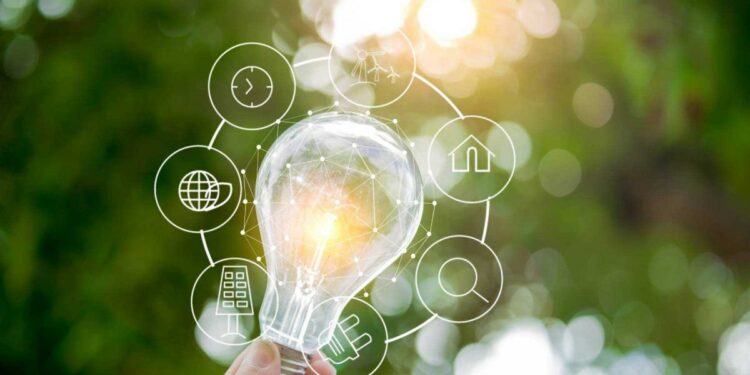Critics of IOT argue that the more gadgets we have, the more energy we consume. That’s just not true. Startling recent figures show that by 2030, IoT solutions will deliver previously unattainable efficiencies, saving enough electricity to run 136 million homes for one year, conserve almost 230 billion cubic meters of water, and eliminate one gigaton of CO2 emissions.
You don’t have to be a captain of industry to reduce electrical consumption and make buildings more sustainable. Even home users and small businesses can adopt IoT devices like smart thermostats and lighting systems to improve energy efficiency.
You’ll just need to take some basic precautions, such as using a secure VPN, to protect older IoT devices against hackers and snoopers. Here’s a quick rundown of how you can get started.
How can IoT help to reduce energy costs?
There are two main ways in which IOT can help you to measure energy use and change consumption trends.
Individual device monitoring:
Use smart plugs and IoT sensors to benchmark or monitor individual devices. You can monitor specific machines, appliances, and devices to quickly understand their energy use or spot faulty or failing equipment.
Integrated systems for buildings or households:
Most smart plugs, IoT sensors, app-based devices, and other IoT tech are compatible with Amazon Alexa, Google Home, Apple Homekit, or IFTTT. That makes it easy to build an integrated system – with voice control – with Siri, Alexa, or Google Assistant.
You can monitor entire heating or cooling systems, lighting systems, or even individual device usage within specific areas and use the data to respond to changing needs in the building. Over time, you’ll be able to identify trends and mark areas for improvement.
For example, smart thermostats can learn how to automatically adjust the temperature based on occupancy and habits. Timed smart thermostats can pre-cool or preheat a space before people arrive. It provides maximum comfort but also reduces the load at peak energy demand periods when the entire city population arrives at offices and starts switching on coffee machines, lights, and computers.
Smart lighting systems can control lighting based on office schedules or input from motion, sound, CO2 level, or humidity sensors to turn lamps and lights on and off as needed to avoid wasteful energy use. You can even set it to switch off lighting according to the quantity of daylight available in a specific area.
Home users have a lot to gain from IoT devices.
Echo, Alexa, or other home systems can orchestrate all your connected smart devices to respond to inputs from each other. If you’re curious or just starting out, there’s a quick way to test and demonstrate the difference between your current system and an integrated smart thermostat and lighting system.
Simply convert some of your “dumb” appliances by using smart plugs. For example, a smart plug will turn an ordinary fan into an IoT device, so you can set it up to switch on if your smart thermostat detects a rise in temperature in a specific room.
Smart plugs use a minuscule amount of energy to stay connected to your Wi-Fi, but the payoff is vast. You can also use them to:
- Identify the heavy hitters among your devices so that you can schedule them for replacement with a more energy-efficient solution. For example, once you know how much energy a space heater gobbles, you may decide to replace it, use it only under specific conditions, or program it to automatically shut down once it reaches a certain level of energy use.
- Slay those energy vampire appliances: “Vampire” devices are those appliances that notoriously keep using energy even when switched off. These energy-leaching televisions, gaming consoles, desktop computers, and monitors can add around $200 to your annual home electricity costs, but they’re a huge hassle to unplug every time. So, using a smart plug to terminate their connections when not in use is a smart move.
- Experiment with minor changes in your devices to identify opportunities for long-term savings. For example, test the electricity consumption in one of your lamps, then change to a more energy-efficient bulb to see if the long-term savings will be worth changing all of the bulbs in your home.
- Outwit your electricity provider’s peak-hour rates. If your utility charges more during the peak-demand hours, you can set timers to operate energy-gobbling appliances during low-demand periods. For example, you can postpone running the dishwasher or charging your toothbrush and the electric vehicle to low-demand periods. And if you own a business, you should know that utilities provide significant economic incentives for businesses participating in demand response programs.
- Shut down devices remotely. You can check and change a device’s on/off status from anywhere in the world, so you can switch off lights or unnecessary appliances in your home while you’re lounging on a sunny beach in the tropics.
Set up your IoT safety first
IoT gadgets have traditionally given hackers an easy way to infiltrate computer networks. Fortunately, IoT security is improving rapidly, but most people still own a mix of secure and less secure Wi-Fi or Bluetooth IoT devices. It’s important to encrypt every data connection to prevent the leaking of your sensitive data. The only way to do this is to force all your data traffic to travel via a dedicated VPN server (VPN gateway). Your VPN service provider has far superior resources to manage cybersecurity.
Download VPN for Chromebook or any other preferred management device. From there, it’s easy to set all devices and appliances to connect via your VPN. Don’t leave any rogue connections that can allow hackers to compromise your network.
Cost and comfort benefits for both businesses and individuals
Your gadgets, appliances, and building consume a lot of energy. IoT is great for everyone’s budget because even modest IoT deployments could reduce your energy baseline by more than 15%, in addition to providing incremental returns in the future. It’s easy and inexpensive to get started and to add systems and devices to expand your system organically in the future.






